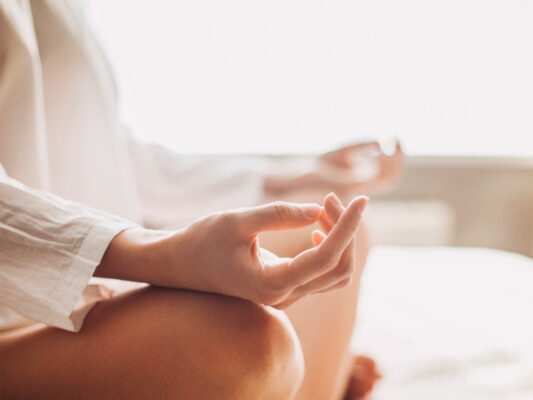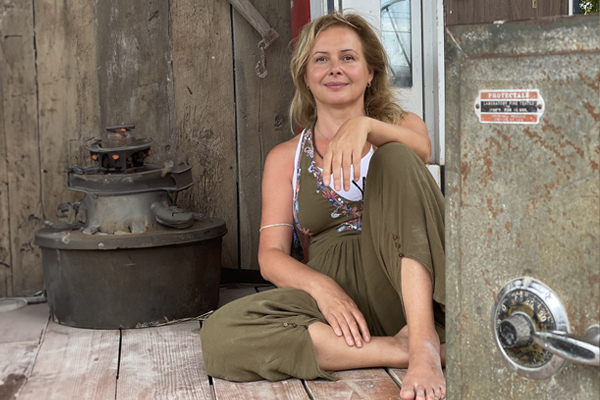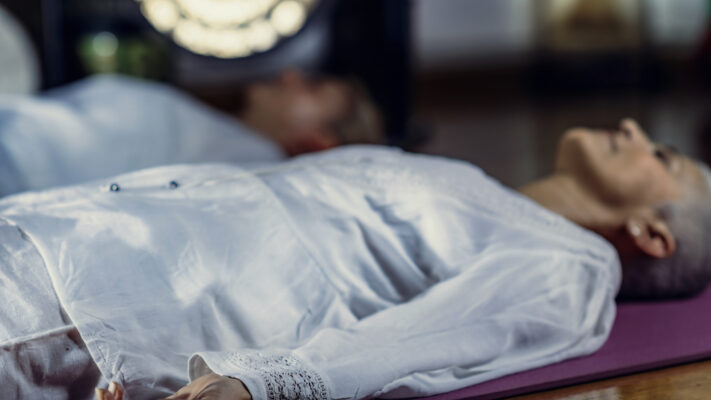Progressive Muscle Relaxation (PMR) is a technique that aims to reduce stress and tension in the body through a systematic approach to tensing and then relaxing specific muscle groups. Developed by Dr. Edmund Jacobson in the early 20th century, PMR is grounded in the principle that physical relaxation can foster mental calmness, thereby reducing overall stress and anxiety levels.
Evicting Stress: How Progressive Muscle Relaxation Unlocks Tension
Progressive Muscle Relaxation (PMR) is a journey, a method, a discovery—not just a technique, but a passage to deeper self-awareness. Its essence lies not in the complexity of its execution, but in the simplicity of its concept: the deliberate tensing and then relaxing of one’s muscles, group by group, to achieve physical and mental relaxation. In This article I’m exploring PMR, unwrapping its layers to reveal the core of its being and the breadth of its utility.
The Genesis of PMR
Back in the early 1900s, a doctor named Edmund Jacobson noticed something pretty straightforward: when people feel stressed out, their muscles get tight, tense up like a tightly coiled spring. He figured if we could consciously relax these tight muscles, we might also be able to dial down our stress levels. So, he came up with a way to do just that, which is what we now call Progressive Muscle Relaxation (PMR).
Here’s how it works: You take it one muscle group at a time, squeeze them as hard as you can for a few seconds, and then let go. It’s like hitting a reset button on your body’s stress levels. You start with your toes and work your way up to your forehead, making your way through different muscle groups. With each step, you’re not just loosening up your muscles; you’re also telling your brain, “Hey, it’s okay. We can relax.”
Think of PMR as your personal stress relief toolkit. It doesn’t require any special equipment or a gym membership. All you need is a few minutes, a bit of space, and the willingness to tune into your body. It’s a straightforward way to ease the tension that life throws at us, making us feel more relaxed and in control.
Now, when diving into the scientific underpinnings of Progressive Muscle Relaxation (PMR), it’s crucial to understand the biological dance between stress and relaxation, and how PMR acts as a choreographer, directing our bodies from a state of tension to one of calm. The effectiveness of PMR isn’t just anecdotal; it’s grounded in the physiology of our stress response and the relaxation mechanisms within our bodies.
The Stress Response: A Biological Primer
By now, most of us are aware that when faced with stress, our bodies kick into what’s commonly known as the “fight or flight” response. This reaction is governed by the sympathetic nervous system, which, when activated, leads to an array of physiological changes: increased heart rate, higher blood pressure, and tense muscles. In today’s world, chronic activation of high alertness can lead to health issues, including anxiety, hypertension, and chronic pain.
Modern life, for all its conveniences, throws curveballs that hit hard. Unlike the more straightforward, albeit perilous, challenges our ancestors faced, today’s stressors are multifaceted and often persist over time. Consider the profound grief of losing someone we love, the ground-shifting uncertainty of serious health issues, or the stark fear associated with becoming a victim of crime. These are not mere inconveniences like traffic jams; they’re profound life events that can shake the very foundation of our existence.
When we talk about the body’s stress response—this “fight or flight” mode—it’s crucial to acknowledge that our physiological reaction doesn’t distinguish between an approaching deadline and a life-altering catastrophe. Whether it’s the stress of facing a serious illness, the emotional turmoil of a divorce, or the anxiety of financial instability, our body reacts with the same hormonal surge, preparing us to face a threat. However, the nature of these threats isn’t something we can run from or physically confront. Instead, they require resilience, emotional strength, and often, a profound reevaluation of our life’s path.
This constant, heightened state of alert—where our heart races and muscles tense—without the physical release that our ancestors had, leads to a build-up of stress that can have significant, lasting impacts on our health. Chronic stress has been linked to a host of issues, including heart disease, diabetes, anxiety disorders, depression, and more. It can exacerbate existing health conditions and lead to a vicious cycle where the physical symptoms of stress further amplify our emotional turmoil.
This is precisely where Progressive Muscle Relaxation (PMR) offers a lifeline. By methodically working through muscle groups, tensing, and relaxing them, PMR allows us a momentary retreat from the mental and emotional cyclone. It’s not just about physical relaxation but about signaling to the brain that it’s time to dial down the emergency response. It’s an act of reclaiming a sense of control when external circumstances feel overwhelmingly chaotic.
Entering PMR: The Relaxation Response
PMR targets this stress response at its physical root: the muscles. By systematically tensing and then relaxing muscle groups, PMR engages the parasympathetic nervous system, the counterbalance to the sympathetic nervous system. The parasympathetic nervous system is often termed the “rest and digest” system, responsible for bringing our bodies back to baseline after a stress response.
Moreover, the practice of PMR can be a form of self-compassion, a way to gently acknowledge what we’re going through and offer ourselves a bit of relief. It’s a reminder that amidst turmoil, finding moments of peace isn’t a luxury; it’s a necessity for our mental and physical well-being.
In the face of life’s profound challenges—be it grief, health crises, or existential threats—the ability to engage in a practice that grounds us, even momentarily, can be a powerful tool in our resilience arsenal. It’s a way to breathe through the storm, to find calm within the chaos, and to remind ourselves that amidst the tumult, there are ways to nurture our well-being.
The Science of Tension and Release
The act of tensing muscles before relaxing them serves a dual purpose. First, it makes you acutely aware of what tension feels like, establishing a clear baseline for what “relaxed” is not. This heightened awareness is key in recognizing involuntary stress responses as they occur. Second, the deliberate release of tension sends signals to the brain to initiate the relaxation response, lowering heart rate, reducing blood pressure, and decreasing cortisol levels—a primary stress hormone.
Research Backs PMR
Numerous studies have illuminated the effectiveness of PMR in reducing symptoms of stress and anxiety. For instance, research published in the “Journal of Clinical Nursing” found that PMR significantly reduced anxiety levels in patients undergoing medical procedures, illustrating how the practice can be a potent tool in acute, stressful situations.
Further, a study in the “International Journal of Nursing Studies” showed that PMR can help manage chronic pain, suggesting that the relaxation of muscles can disrupt pain-tension cycles. This is particularly relevant for areas like the shoulders and neck, where tension often accumulates, leading to discomfort and further stress.
Hormonal Effects
The benefits of PMR extend to hormonal regulation. By activating the parasympathetic nervous system, PMR helps to reduce the production of stress hormones like cortisol and adrenaline, promoting a state of calmness. This hormonal shift not only feels good in the moment but can have long-term health benefits, including improved immune function and decreased risk of chronic stress-related diseases.
A Tool for Emotional Regulation
Beyond its physical benefits, PMR can also be a powerful tool for emotional regulation. The act of focusing on the body and breath, inherent to PMR, promotes mindfulness—a state of being present and fully engaged with the moment, free from distraction or judgment. This mindfulness component can help individuals navigate through strong emotions like grief and loss, providing a sense of grounding and stability amidst emotional turmoil.
PMR practice
Benefits of PMR:
Cutting Down Stress and Worry: PMR helps you relax your muscles, which in turn can make you feel less stressed and anxious.
Better Sleep: It can also help you sleep better. By helping you relax, PMR makes it easier to fall asleep and improve the quality of your sleep, especially if you often find it hard to switch off at night.
Pain Relief: If you have ongoing pain, especially in your muscles, PMR can be a big help. It works by easing muscle tension, which can reduce pain.
Being More Mindful: Practicing PMR can make you more aware of how your body feels and what emotions you’re experiencing, helping you be more in the moment.
Sharper Thinking: When you’re less tense and stressed, your brain can focus better. This means you could find it easier to concentrate, solve problems, and come up with new ideas. It’s especially good for anyone who needs to be creative or think deeply for work or school.
Keeping Emotions in Check: Regularly doing PMR can make you feel more emotionally stable. It helps you handle stress better, so you’re less likely to have mood swings and can stay more balanced when life gets tough.
Boosting Your Health:
- Less Pressure on Your Heart: By calming down stress, PMR can help keep your blood pressure in check.
- Digestion: Stress can mess with your stomach and digestion. PMR helps you relax, which can make your digestive system work better.
- Fighting Off Germs: Lower stress levels can make your immune system stronger, so you’re better at fighting off colds and other infections.
In short, PMR is all about relaxing your muscles step by step, which has a domino effect of benefits, from easing your mind to helping your body stay healthy.
In essence, PMR is more than just a series of exercises; it’s a bridge to better health, offering a scientifically validated pathway from the stress-induced “fight or flight” mode to a more peaceful “rest and digest” state. By leveraging our body’s natural relaxation mechanisms, PMR provides a practical, accessible means to enhance physical and emotional well-being in a stress-saturated world.
Be Alive 🌱,
❤ Love, Julia
The Tension Takedown: How Progressive Muscle Relaxation (PMR) Helps You Let Go of Stress 🎧 ▶️
In the throes of everyday hustle, stress has a way of making its home within [...]
Mind ∞ Body
How to Do Body Scan Meditation to Get the Most Benefits 🎧 ▶️📝
Right off the bat, let’s clear the air about something: when we talk about body [...]
Listen Closely: Your Body is Speaking
Ever stop to think about the hustle happening inside you every moment? Your heart’s ticking [...]
Bare Narratives: The Stories We Wear
Skin Stories We’ve been conditioned to see our bodies as projects, billboards for our successes [...]
The Tension Takedown: How Progressive Muscle Relaxation (PMR) Helps You Let Go of Stress 🎧 ▶️
In the throes of everyday hustle, stress has a way of making its home within [...]
GUIDED MEDITATIONS 💗
DISCLAIMER: The materials and the information contained on the Positive Pranic website are provided for general and educational purposes only and do not constitute any legal, medical, or other professional advice on any subject matter. None of the information on our videos is a substitute for a diagnosis and treatment by your health professional. Always seek the advice of your physician or other qualified health providers prior to starting any new diet or treatment and with any questions you may have regarding a medical condition. If you have or suspect that you have a medical problem, promptly contact your health care provider.






















